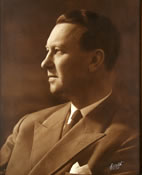H. C. Hansen
| Hans Christian Hansen | |
|---|---|
 |
|
| Prime Minister of Denmark | |
|
In office 1 February 1955 – 19 February 1960 |
|
| Monarch | Frederick IX |
| Preceded by | Hans Hedtoft |
| Succeeded by | Viggo Kampmann |
| Personal details | |
| Born |
8 November 1906 Aarhus, Denmark |
| Died | 19 February 1960 (aged 53) Copenhagen |
| Political party | Social Democrats |
Hans Christian Svane Hansen (8 November 1906 – 19 February 1960), often known as H. C. Hansen or simply H. C., was a social democrat and Prime Minister of Denmark from 29 January 1955 to 19 February 1960 as the head of the Cabinet of H. C. Hansen I and II. Before becoming Prime Minister, H. C. Hansen also served as Finance Minister in the Cabinet of Hans Hedtoft I and Foreign Minister in the Cabinet of Hans Hedtoft II. Hansen was trained as a typographer. He was a secretary and later chairman in the Social Democratic Youth and became a member of parliament in 1936.
As Foreign Minister, H. C. Hansen was seen as the natural successor as Prime Minister and leader of the Social Democrats, when his friend Hans Hedtoft died of a heart attack on 29 January 1955. In addition to becoming Prime Minister, H. C. Hansen also retained the post as Foreign Minister until 1958. Amongst the laws passed by this government included the universal people's pension and the enactment of agricultural price supports. The law on assistance to single mothers of April 1955 introduced special assistance for widows with children and certain other categories of single women, while under the Accident Insurance Act of 1959, an independent board of appeal was set up, waiting times were reduced, compensation for survivors was converted from lump sums into running benefits, and the scheme extended to cover occupational diseases. Under a law on relations between trade union a and employers’ associations, passed in April 1956, as an offshoot of collective agreement on the labour market, a new scheme provided sickness cash benefits significantly higher than in the existing health insurance scheme. The new scheme only covered members of trade unions and those employed by members of the Danish Employers’ Association. In addition, under the Apprenticeship Act of September 1956, theoretical training was introduced at technical schools as part of apprenticeship training. In 1956, universal pension coverage in Denmark was introduced, while the Survivors’ Pension Act of March 1959 introduced a general survivors’ pension scheme, including specific provisions for single women having reached age 60. In 1959, a law was enacted that led to the establishment of the Mental Retardation Service and a decentralised regional system of services for those with intellectual disabilities. That same year, an extension of covered occupational diseases in work injury compensation was carried out. In 1958, an education reform was enacted that reduced educational barriers.
...
Wikipedia
